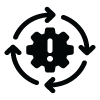Distributed ReStart

Problem
Global, regional and country organisational policy to address climate change over decades has driven change in the global electricity industry as we move to cleaner sources of electricity generation. One resulting impact in many countries including the UK, that is continuing at pace, is the transition of large scale transmission connected generation to increasing levels of smaller scale distribution network connected generation. This transition to distributed energy resources (DER) in Great Britain while supporting many benefits also results in many challenges that are presently being addressed.
Distributed ReStart is a world-first initiative. The project explores how all forms of DER, synchronous and converter connected, scheduled and intermittent including solar, wind, hydro, energy from waste, CHP, ESS etc. can be used to restore power to the GB transmission network in the unlikely event of a blackout - a process known as Black Start.
This would remove the ESO dependence on large and costly fossil fuel generators to provide a Black Start service. This ground-breaking approach would create the blueprint for international adoption.

Solution
With the displacement of large fossil fuel based transmission connected power stations with smaller distribution connected generation the concept is to restore islanded areas of the distribution network called Distribution Restoration Zones (DRZs) using DER as part of a national Black Start.
These island networks would then synchronise with restored sections of the transmission network supporting transmission restoration where transmission connected Black Start power station capability is limited.
This Black Start strategy introduces the concept of the Distribution Restoration Zone Controller and Anchor Generator associated with each distribution network island:
- DRZ – Distribution Restoration Zone, a distribution system island 33kV (possibly 132kV) with a suitable Anchor Generator.
- Anchor Generator – A DER with self-starting capability and other technical capabilities required to create an independent voltage source, control frequency and voltage and support demand pickup.
- Top Up Services Providers – Other contracted DER (wind, solar, ESS) that can support the Anchor Generator during black start operations.
- DRZ Controller - The DRZC supports the automation of the process of black starting the DRZ island network; provides fast balancing of voltage and frequency for block load pickup supported by BESS or load banks where required; provides slower balancing of demand and generation to maintain the DRZ voltage and frequency; and provides suitable synchronising back to a reinstated transmission network or to other black started DRZs.

Result
Smarter Grid Solutions (SGS) worked with the Distributed ReStart team to develop a DRZC functional design that will provide the monitoring and control required throughout the DRZ island Black Start process, utilising a wide range of expected DER types.
The DRZC solution architecture developed by SGS would suit wide scale deployment. The architecture has two basic layers.
- A central control room layer that provides control and monitoring as the DRZC progresses through 7 stages of DRZ island black start restoration.
- A local fast response control layer that responds to protect the stability of the DRZ island from destabilising events such as a major loss of DER or demand and supports synchronised switching onto other DRZ island networks and the restored transmission network.
While SGS’s DRZ Controller design was not adopted by Distributed ReStart for the build and hardware in the loop testing phase, the learnings from this project have already been applied in microgrid designs for other SGS clients. The difference from Strata Resilience and previous distribution control schemes, is the application of fast (sub-second) control required for frequency control which is relevant on non-grid connected islanded networks. The application of SGS’s Strata Resilience control platform combined with fast controller elements to protect system stability is also featuring in other microgrid control applications.
The concept of combining SGS’s advanced Strata Resilience control platform with other third party fast local controllers could open up markets to SGS for sub transmission DER management where super-fast remedial action would also be required to rapidly reduce generation export on loss of a circuit to avoid demand customers being tripped through existing protection actions.
More Information
NESO Official page: Distributed ReStart
Want to learn more?
Book a custom demonstration with our Smarter Grid Solutions Division team.

